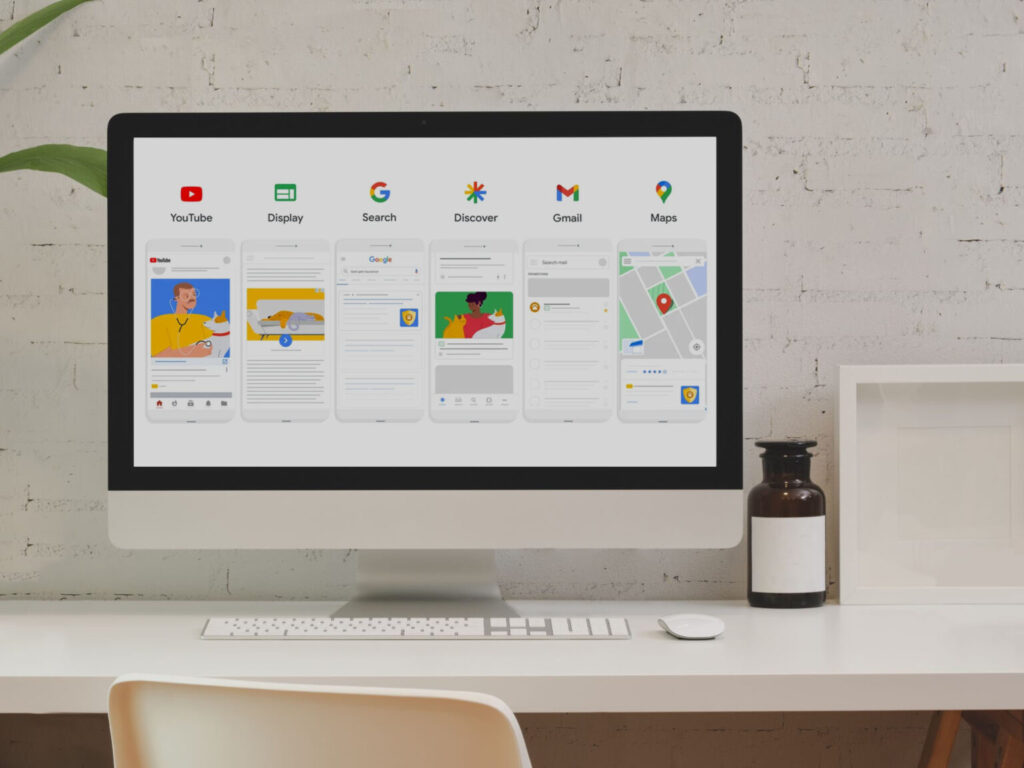Performance Max or PMax, provides a unified buying service to all Google placements, displaying ads across YouTube, Display, Search, Discover, Maps, and Gmail. It is Google’s newest innovation, utilising machine learning to optimise your bids and maximise conversions within your target cost-per-conversion (CPA). To run them, you need to provide Google with your:
- Marketing objectives and goals
- Budget
- Creative assets (text, images, video)
- Geo-targets
- Google My Business
- Google Merchant Center
- Dynamic Ads feed
- Business data feeds
Having been launched just over a year ago, in November 2021, we wanted to explore some of the pros and cons of Performance Max to help you decide if it is something you should be exploring in your future campaigns.

The Pros of Performance Max
Automation
Performance Max uses automation to simplify the ad campaign setup process and optimize ad performance for advertisers.
By selecting easy setup in your campaign settings (which includes budget and bid strategy) and adding necessary assets(which include your creative assets and audience signals to guide targeting), Google does the rest.! Using its automation tools to find the best audience understanding your business.
It leverages machine learning algorithms and audience signals to automatically target users who are most likely to engage with the ads and take desired actions without requiring manual bid or audience targeting adjustments. Furthermore, you can add your unique expertise, such as budget, business goals, and conversions, that you want to measure to tailor the information you get at the end.
Optimised for High Impressions & Reach
As Performance Max takes advantage of all of Google’s inventory, these campaigns result in a very high number of impressions. Much higher than your average search campaigns. That’s because Google is showing your ads in every possible placement and ad type that could result in a conversion.
Whether it’s headlines, descriptions, images, or videos, Performance Max consolidates all of your assets to create customised, compelling ads across Google channels. Your assets are mixed and matched to find what performs best together, meaning your ads are constantly being optimised for relevance and, therefore, performance. Since this campaign utilises all of Google’s inventory, it may allow you to run ad types that you haven’t before or that haven’t performed as well as you would have liked
For example, we could see high cost per conversion and low ROAS in standard Display or Discovery campaigns while you can see a much lower cost per conversion and higher ROAS from Performance Max thanks to the involvement of google’s machine optimisations.
Advertisers can also choose from several performance goals, including conversion value, return on ad spend, and target CPA. This customisation allows you to tailor the bidding strategy to your specific business needs and achieve better results.
Time Saving
The beauty of automation is that it helps us complete recurring tasks much quicker. For Pmax, this includes many different areas.
One area is that you won’t have to worry about the campaign budget. Before setting up a manual campaign, you need to decide how much you want to spend and what type of bidding strategy you want to use.
With PMax, Google handles all this for you. As it is automated, you don’t have to manually do keyword research or audience creation—Google’s machine learning will do it all instead. This benefit can be a huge time saver for ad managers with busy schedules and novices.
For example, In a PMax campaign, you create ad copies and images and assign them to one Asset group. From the information we provide, Google will automatically generate ads with different combinations of images/ad copies/video assets and show those ads to the users who fit the audience you define your audience signal.
Performance Max aims to maximise conversion value, so the algorithm will adjust bids to get the most conversions possible within your budget. This can lead to increased efficiency and a better return on investment
So those are just a few of the positives PMax is bringing to the table. What about the other side of the coin?

The Cons of Performance Max
Less Control
With Performance Max, you are surrendering control over your bids to Google’s algorithms, which may not always align with your goals and preferences. The main drawback to running a PMax campaign is the low control we have over the targeting and performance data. The advertisers cannot access keywords or audience data, which also means you cannot use the insights across your other channels OR make adjustments where you know they need to be.
Users can’t add negative keywords or use smart bidding strategies in PMax campaigns, which may accelerate unwanted clicks to the ad. You must rely on your campaign manager for these tasks instead.
Less control makes it easier and easier to spend money with Google. Google’s ad inventory is vast, and if we aren’t narrowing down our targeting, the capacity to spend is high. This benefits Google while not always benefiting the advertiser.
Lack of Transparency in Reporting
The Lack of transparency around Performance Max’s bidding decisions can make it difficult to understand why certain bids were made and how they impact your campaigns.
In a PMax campaign, Google is using an organizational structure called Asset Groups which are similar to Ad groups in that you can create an Asset Group around a particular brand or a category of items. For example, if you are selling wines, you can create an Asset Group for white wine, an Asset Group for red wine and another Asset group for sparkling wines, all in the same performance max campaign.
While that’s fine, there is one major structural issue to be aware of when developing a Performance Max campaign. Google currently only reports data at the campaign level. You cannot get data at the individual Asset Group level. This makes it difficult to estimate which one(S) of the Asset Groups is performing the best and which one(s) are underperforming.
It’s not just a matter of Asset Group level reporting; it is also difficult to track the ad click sources. We may not have a clear picture of where the clicks are coming from, for example, via an image, video or shopping ad. While Google’s A.I may be optimising; as experts, we may see a pattern faster or be better able to better understand the reasons behind a specific action.
When looking at the data from a PMax campaign, you’ll also want to see how the keyword or audience you’re bidding on is performing. This result may be difficult with keywords or audiences when we can’t access enough data and separate which clicks came from what audience.
Google is adding new reporting features over time, but the consensus is that it’s hard to get separate insight into each campaign or combination of assets.
Little Search Term data
Similar to the target audience/ source report limitations, the advertisers have only limited exposure to the search terms, but it’s not as extensive as search term reports from search campaigns. Even though we get some information from the insights tab, it would be great to get more insight.
Not only could this help improve future campaigns and deliver insight into success, but as stated above, it can assist in other areas of your marketing, such as SEO. If a specific Keyword/question is performing well from a paid perspective, then it could indicate a strong idea for an organic approach also.
An Exciting New Option
In Conclusion, Performance Max is an exciting new option for both paid media novices and experts to try. It’s easier for the newbies who are learning and searching for quick ways to set up a campaign.
Overall, PMax can be a valuable tool for advertisers looking to maximise the performance of their campaigns. However, it’s essential to understand the pros and cons and to carefully consider whether it’s the right choice for your business before implementing it.
PPC experts can help with this, using a blend of PMax campaigns alongside traditional PPC techniques to ensure you get the best results.
Interested? Get in touch

